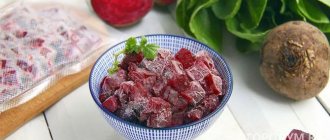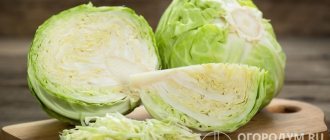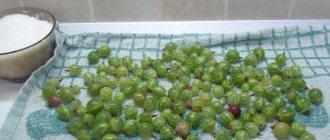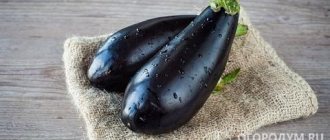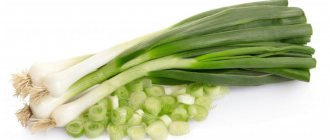How to freeze eggplants for the winter in the freezer at home without spoiling the product is described in detail in our article. The peculiarity of eggplants is that when frozen , their taste and structure change significantly. For this reason, it is important to follow certain rules in this process. It should be noted that when freezing fresh eggplants, it is possible to preserve nutrients in greater quantities compared to canned vegetables, which is a definite advantage.
How to choose the right fruits
Eggplants are selected according to the same rules that are used for canning:
- Pedicel. The color of the fruit's tail should be green. Eggplants whose stems have dried out frozen . Since this indicates that the vegetable was stored for a long time after being picked from the bush;
- Surface quality. The surface of the eggplant should be glossy, there should be no bumps, growths, damage or stains - this fruit is most suitable for freezing;
- Color. It is necessary to choose fruits that are evenly colored;
- Maturity and size. Young best suited for freezing , since large and ripe fruits contain a large number of seeds. Their skin and flesh are tougher.
Advice! To avoid the production of the toxic substance solanine in eggplants, a significant concentration of which is harmful to the health of the body, they should be protected from light during storage. Even a small amount of this component in the vegetable gives it a bitter taste.
When cutting eggplants, popularly known as blue ones, you should pay attention to the color of the cut. Its rapid darkening indicates that the fruit will be bitter, since it contains solanine in large quantities. Light-cut vegetables are more suitable for freezing
Preparing vegetables for freezing
Preliminary preparation does not take much time, but this is a very important stage, without which the taste of the blue ones will be poor. You can freeze eggplants in different ways, but for all methods there are general rules that must always be followed. The first concerns the freezer. The temperature inside should be at least 12 degrees below zero. At this temperature, eggplants can retain their unique taste and beneficial properties for 12 months.
You can keep the little blue ones in the freezer only in sealed packaging, otherwise they will absorb the aromas of the products that are nearby. If it is a plastic bag, then the vegetables should be wrapped tightly so that there is no air left inside. But it is additionally recommended to remove all products with a strong odor away from eggplants. This is especially true for greens.
A mandatory process is soaking the vegetable in salt. It is needed to get rid of the bitterness that is inherent in eggplants. Usually a saline solution is prepared in which the eggplants are kept. It is easier to sprinkle chopped vegetables with salt and leave for a while until they release their juice.
How to freeze eggplants fresh for the winter
When freezing blue ones, you should ensure they are stored airtight. Sliced vegetables are placed in tightly closed packaging, which prevents air from entering the eggplants in the refrigerator. This prevents oxidation of the fruits and the penetration of foreign odors from other products stored in the freezer. This tip, as well as those described below, helps to properly freeze eggplants using any of the proposed methods.
It is easy to ensure the tightness of the package using a vacuum sealer, but you can do without it. At the same time, when freezing vegetables, they use zip bags and ordinary cocktail straws. After placing the vegetables, the bag is closed almost completely, leaving only a small access for a plastic straw. Having inserted it inside the bag, use your mouth to suck the air out of it until the walls of the package stick to the vegetables. Then the tube is carefully removed and the bag is closed completely.
To freeze eggplants at home, you must follow these steps:
- Pre-soak. This stage of fruit preparation should not be abandoned, otherwise bitterness may remain in them, which will make the product unsuitable for consumption. For this reason, before freezing, it is recommended, first of all, to soak the sliced eggplants in a solution of water and salt, after which they must be washed well in clean water;
- Remove moisture. Before placing in the freezer, eggplant should be dried from any water or excess vegetable oil, patted with a paper towel;
- Sign the packaging. In the freezer, plastic containers and bags of vegetables are covered with frost, which makes all the containers look similar to each other, and it is not easy to determine exactly where, for example, eggplants .
Reference! Airtight packaging allows you to store frozen eggplants in the freezer (at a temperature of -12°C) for no more than a year. Exceeding this shelf life negatively affects the taste characteristics of the little blue ones.
Important! It is better to freeze eggplants in portions, as much as you need at a time. Otherwise, when repeatedly frozen and defrosted, they lose their taste and beneficial elements.
Is it possible to freeze eggplants?
You can freeze eggplants at home. The main thing is to decide on the quantity. The fact is that frozen eggplant must be consumed before the onset of the new season. Otherwise, all taste and beneficial qualities will be lost.
Points for and against:
| BEHIND | AGAINST |
| beneficial properties are preserved | If pre-processed incorrectly, you may end up with an inedible product. |
| long shelf life | require preliminary heat treatment |
| can be cooked without defrosting | inconvenient to store: vegetables absorb odors, they need a lot of separate space |
| Widely used in cooking when frozen | — |
| various types of pre-treatment | — |
Changes in composition and taste
Taste qualities change only when fresh vegetables are frozen. The taste will be bitter and unpleasant. In addition, the shape of vegetables is also lost. In other cases, taste qualities do not change. The vegetable turns out aromatic and juicy. When frozen, only 20% of the beneficial properties are lost, and when preserved - 40%.
Options for processing eggplants for freezing
Frying
Is it possible to freeze fried eggplants for the winter ? Yes.
- Wash the eggplants, cut into slices up to 0.7 cm thick. If you cut them thinner, during frying the pieces will become even smaller and will not be suitable for freezing in the freezer;
- To get rid of bitterness, vegetables should be salted and waited for about 30 minutes. Then rinse with clean water;
- Place the pieces on the grill, baking sheet or other similar surface and leave to dry. To speed up the process, you can pat the eggplant with a paper towel;
- Add a little vegetable oil to a hot frying pan and lightly fry the eggplant for a few minutes on each side. Stop frying the pieces when they have a light golden crust;
- Place the eggplant on a wire rack, cool to room temperature and place in the refrigerator compartment to freeze at a temperature below -12˚C;
- After 90 minutes the eggplants from the freezer, remove them from the wire rack and pack them into bags, again placing them in the freezer, where they are stored until use;
- Place stickers on bags of eggplants, indicating the name, weight and method used to prepare the product for freezing;
- You can cut the blue ones into cubes or bars, depending on your plans for preparing dishes after defrosting the vegetables.
Baking
- Cut the eggplants into circles or slices, which are great for later preparing rolls;
- Preheat the oven until the temperature reaches 180˚C;
- Place the blue ones on a baking sheet greased with vegetable oil and put them in the oven for half an hour;
- After a quarter of an hour, turn the pieces over so that both sides of the sliced eggplants are baked;
- Then repeat the same steps as indicated for fried eggplants: dry, place in the freezer for 30 minutes, pack into packages as much as is needed for 1 time, ensure the seal is sealed inside them, stick stickers, and then store in the freezer until use.
Extinguishing
- Add a small amount of vegetable oil to the saucepan and heat it;
- Place the eggplant and, stirring from time to time, simmer the vegetables until tender; you can add salt and pepper to taste;
- Remove from heat and cool to room temperature;
- Transfer the stewed eggplants into bags or containers and place them in the freezer freeze
Blanching
- Pour water into a saucepan, boil, salt well and add 1 tbsp. a spoonful of lemon juice (you can squeeze fresh juice from half the fruit);
- Boil eggplant pieces
- Remove the vegetables with a slotted spoon and immediately plunge into ice water;
- Remove and dry the eggplants;
- After this, the blue ones can be frozen.
Cooking
- Cut off the tails of the fruits, pierce the eggplants with a needle or toothpick;
- Soak the vegetables for 45 minutes in a solution of table salt, removing the bitterness; such a long time is necessary due to the fact that the processing of blue vegetables is carried out in a whole, uncrushed form;
- the eggplants in it for 20 minutes from which the bitterness has previously been removed;
- During boiling, vegetables shrink, they should be cooled and chopped using any convenient method, after which the product is ready for freezing.
Freezing the whole fruit
- Eggplants are exposed to high temperatures without peeling. To do this, whole vegetables can be stewed in a slow cooker, baked on the grill, or boiled using the method described above;
- Then cool the blue ones and dry the moisture from their surface with a paper towel;
- Carefully wrap the vegetables separately in a thick layer of cling film and place in the freezer.
Advice! You can freeze whole eggplant fruits by preserving the skin or peeling the vegetables, depending on the form in which they will be eaten.
Blanks for rolls
It is incredibly convenient to prepare frozen eggplant using special preparations. For this:
- Wash and dry the vegetables without peeling them;
- Remove the stems, cut the eggplants lengthwise into long slices 5-8 mm thick;
- Place in a container of suitable size, salting each layer;
- Leave for half an hour, then rinse well in clean water and dry;
- Place the eggplant in one layer on baking paper, which is used to cover a baking sheet, and bake in the oven at 200˚C for about 15 minutes;
- Eggplants should definitely be baked in one layer, if necessary in several batches;
- Then take out the baking sheet and cool the vegetables;
- Spread cling film on a tray, arrange the eggplant in one layer, if necessary, place many layers, cover each layer on top using film, and then freeze the pieces for several hours;
- Then take out the blanks and place them in bags or containers, getting rid of the film.
Reviews
We invite you to read the reviews of those housewives who have already tried frozen eggplants.
Valentina Orlova, Perm: “I have been preparing frozen eggplants for several years now. I really like their taste. Before freezing, I blanch vegetables, it seems to me that this is the fastest and most convenient way. I'm generally a big fan of frozen foods, so I bought a freezer with small compartments. I store eggplants not in a container, but in bags. I prepare vegetable salads. And on the New Year’s table, vegetable stew with chicken breast is wonderful.”
Larisa Yampolskaya, Ulyanovsk: “At the dacha we shared the harvest with our neighbors. I don’t grow eggplants myself, but here they brought me a whole basket. I didn’t know what to do with them, so I decided to freeze some of them. Unfortunately, I didn’t know whether it’s possible to freeze fresh raw fruits. They turned out bitter and watery. Now I know that heat treatment is required. I bought eggplant seeds and will grow them myself.”
Olga Menshikova, Irkutsk: “I have a large family, and I always need pickles at the table. I froze eggplants for the first time this summer; initially I dried them in the oven with pepper. Now once a week we prepare dishes with frozen eggplants. We have already tried stew, buckwheat porridge, vegetable salad, stewed vegetables with cheese. Delicious!"
Defrosting rules
freeze vegetables no more than once. Therefore, re- freezing eggplants after thawing is prohibited. For this reason, it is necessary to properly distribute the portions of blueberries in packages before placing them in the freezer. In this case, you can easily use the amount of vegetables that is required in each specific situation. The following are the ways to use the product:
- To defrost eggplants, you can simply remove them from the freezer, place them on a large plate and leave them to defrost at room temperature without using any auxiliary electrical appliances;
- To prepare some dishes, you do not need to defrost vegetables; in this case, you can start frying or boiling eggplants immediately after they are taken out of the freezer.
Watch the video! How to properly freeze eggplants for the winter
Why are eggplants called blue?
There are several versions of the origin of this name. The first is linguistic: eggplants were originally brought to the territory of modern Israel from China, pronounced “sin” in Hebrew, and only then, in the 17th century, when eggplants reached Russia, they were dubbed “blue ones.”
The second version is based on sad experience: since for a long time nothing was known about the caution with which one should approach the choice of fruits, and the vegetable was perceived as rare and expensive, solanine poisoning occurred, which caused the skin to turn blue. Hence the nickname – “little blue”.
Frozen Eggplant Recipes
Eggplant caviar
We will need:
- 1 kg of eggplants;
- 3 onions;
- 3 carrots;
- 70 ml sunflower oil;
- Salt, pepper, spices to taste.
How to cook:
- fry onions and carrots;
- add thawed eggplants, cut into cubes, salt, pepper, season with spices;
- simmer, when the dish is almost ready, add a little chopped garlic;
Potatoes fried with blueberries
We will need:
- 0.5 kg eggplants;
- 2 onions;
- 0.5 potatoes;
- 70 ml sunflower oil;
- 2 cloves of garlic;
- Salt, pepper, spices to taste.
How to cook:
- fry onions with potatoes and eggplants, cut into cubes or circles, in different frying pans;
- after that, mix the ingredients and fry a little more, adding a small amount of garlic, spices and herbs.
Eggplant rolls
- defrost the blue “tongues”, put the filling on top to taste, place in a baking dish;
- grate the cheese and sprinkle it over the eggplant pieces, bake in the oven until the dish is ready.
Vegetable stew
We will need:
- 0.5 kg eggplants;
- 3 onions;
- 3 carrots;
- 3 bell peppers;
- 2 tomatoes;
- 70 ml sunflower oil;
- 2 cloves of garlic;
- 100 g cheese (Dutch, Russian)
- Salt, pepper, spices to taste.
How to cook:
- defrost and fry the eggplants, add chopped vegetables to taste, the dish can be prepared using onions, carrots, bell peppers;
- simmer, when the stew is almost ready, you can add an arbitrary amount of chopped tomatoes, garlic, seasonings and herbs, if desired;
- grate the cheese, sprinkle it on the dish and let the cheese melt under the lid.
Buckwheat porridge with eggplant
We will need:
- 500 g buckwheat porridge
- 0.3 kg eggplants;
- 2 onions;
- 50 g butter;
- Salt, pepper, spices to taste.
How to cook:
- boil buckwheat, 2-3 hard-boiled eggs;
- fry onions with eggplants;
- add butter, chopped eggs, fried vegetables to the porridge, season with spices and herbs as desired.
Casserole with meat and eggplant
We will need:
- 250 g of any minced meat (chicken, pork, beef);
- 500 g eggplants;
- 50 ml sunflower oil;
- salt, pepper, spices to taste.
- 1 raw egg;
- 200 ml milk;
- 2 tomatoes;
- 150 g cheese (Dutch, Russian);
- 2 cloves of garlic.
How to cook:
- take a little minced meat from any meat, a couple of cloves of garlic, a raw egg, salt, season with pepper and other spices, mix all the ingredients;
- distribute the mixture over the baking dish and a little on its sides, put eggplants on top, which must first be thawed and fried;
- Place the tomatoes cut into slices on them, beat an egg, add milk to it, pour the mixture into a mold, grate the cheese, sprinkle it on the dish and bake in the oven.
Eggplant paste with nuts
We will need:
- 500 g eggplants;
- 50 ml sunflower oil;
- salt, pepper, spices to taste.
- 1 teaspoon vinegar;
- 3 tbsp. spoons of walnuts;
- 2 cloves of garlic.
How to cook:
- defrost vegetables, fry them with vegetable oil, mash with a fork;
- add vinegar, some walnuts and garlic, which have previously been chopped;
- season with cilantro and other herbs if desired, stir and garnish with pomegranate seeds.
eggplants turn out to be very appetizing there are also many recipes for delicious salads with blueberries.
Selection of fruits for storage
In order for dishes from vegetables prepared for future use to be tasty, you need to select the right fruits before storing them. Ideally, they are grown on their own site without nitrates, pesticides and other harmful substances.
Eggplants suitable for freezing:
- young, with elastic, soft, thin skin - old fruits have a thick skin and a bitter taste;
- with tails without signs of drying out - this indicates the freshness of the product.
- You should not buy vegetables from supermarkets - large farms often use increased doses of mineral fertilizers and spray crops with toxic pest control agents.
Fruits that are broken, damaged by insects, or have skin defects are not suitable.
Useful properties of the product
Eggplants, fresh and frozen, are rich in substances beneficial to human health:
- vitamins C and group B;
- microelements (calcium, phosphorus, potassium);
- pectin and fiber.
The vitamins that make up the vegetable are not very diverse, but eggplants are known for their low calorie content and pectin content, which improves the functioning of the digestive system and helps remove bile and excess cholesterol. Potassium rids the body of excess fluid and normalizes the functioning of the cardiovascular system. For these purposes, it is especially useful to consume baked or stewed fruits. Eggplants help prevent diseases such as atherosclerosis, anemia, osteoporosis, osteochondrosis, and gout.
Reference! Due to the content of vitamin PP (niacin) in eggplants, they help fight nicotine addiction, alleviating the symptoms of “nicotine starvation.”
The use of frozen eggplants is not fundamentally different from the use of fresh ones. However, the taste of the latter is more expressive and strong. For this reason, it is easier to prepare an appetizing dish from fresh, high-quality vegetables purchased in a store or market. And if this is not possible, frozen eggplants can be an excellent option to diversify your diet.
Watch the video! Freezing eggplants for the winter
Recommendations for the selection and preparation of raw materials
The selection of fruits intended for harvesting for long-term storage should be approached very carefully. The fact is that eggplants contain a plant poison - solanine, which tends to accumulate while the vegetable is growing, and after harvesting, the concentration of solanine in the fruit continues to increase as it “ages”. Therefore, their consumption in raw form is not recommended at all.
Today, breeders have developed a huge number of varieties and hybrids of the crop, the fruits of which vary greatly in color, shape and size, which is clearly visible in the photo
Suitable for freezing are small eggplants, elastic to the touch, with a strong green stalk, smooth shiny skin, without external damage, and without an unpleasant odor. If you cut such a vegetable, inside it has light, almost white pulp, which after a few minutes begins to darken at the cut site, and small seeds that do not contain coarse lignified fibers.
If you plan to preserve the harvest grown in your garden, then the consumption of “stale”, unripe or overgrown fruits is kept to a minimum.
Recommendations for housewives who buy vegetables at the market or in a store:
- It is better to avoid buying and eating soft fruits, as well as specimens that are too large;
- Having brought the vegetables home, wash and cut the eggplant; if the flesh has a greenish tint or immediately darkens, the concentration of solanine is quite high; such fruits are also not recommended for consumption.
The degree of maturity of a vegetable is clearly understood by the color of the seeds; usually the brighter they get, the rougher they get
Solanine is not destroyed even by heat treatment (below 250 ℃) and freezing, and in order for dishes prepared from frozen raw materials to be safe, two conditions must be met: carefully select and freeze eggplants correctly.
Fresh, ripe “little blue” – tasty and healthy, a real storehouse of vitamins and nutrients
The content of vitamins A, C, B, B2, PP and potassium in eggplants helps normalize metabolic processes in the body and improve the functioning of the cardiovascular system. People watching their figure value them as a low-calorie product - only 25 kcal per 100 grams.
How to Make Eggplant Safe to Eat
Most modern “blue” varieties are devoid of bitterness, but for those who are afraid of poisoning, we offer a proven algorithm of actions:
- Remove the skin before cooking - the highest concentration of solanine accumulates in the skin of dark varieties, and the lowest in light varieties. Therefore, if you prefer to eat vegetables with peel, it is better to choose white fruits.
- Soak for at least an hour in salted water before further processing or cooking - soaking will significantly reduce the concentration of solanine. It is advisable to change the water several times during the process.
According to numerous reviews, adding acid helps to better preserve the color of the pulp of the cut pieces
Now housewives, as a rule, do things simpler: if the fruits are young, then they are immediately cut into pieces, placed in a convenient container, generously salted, sprinkled with lemon juice or natural vinegar, mixed and left for 20-30 minutes. After the vegetables have released their juice, they are discarded in a colander, washed under running water and allowed to drain.
How to store and use
The options for using frozen eggplant are varied. What can you cook from them:
- salads;
- stew;
- stuffed rolls;
- first meal.
Eggplant storage conditions and expiration dates are presented in the table:
| Type of processing | Temperature, °C | Duration, months |
| Raw | -12-18 | 6 |
| Boiled, “boats” | 3 | |
| Dried in the oven | 4 | |
| Blanched | 3 | |
| Fried | 3 | |
| Baked | 3 |
If the storage period is exceeded, the taste of the fruit will deteriorate and vitamins will be destroyed. Eggplants become flabby and tasteless.
Photo
The photo shows how to prepare eggplants for freezing.
Rinse thoroughly:
Slice:
Place in a bag:
How to store in the refrigerator?
In the refrigerator, this product retains its freshness much less than in the freezer. However, this method is suitable for short-term storage of the blue fruit a few days before its preparation. In addition, you can keep unripe fruits in the refrigerator until they ripen.
Rules for storing eggplants in the refrigerator:
- It is advisable to store this product in a special compartment of the refrigerator intended for vegetables and fruits. Before this, the fruits must be wiped with a dry cloth. They need to be washed immediately before cooking.
- It is recommended to wrap each eggplant individually in cling film, paper or a bag.
- Place the product in the appropriate refrigerator drawer.
- Periodically, eggplants should be sorted, removing fruits with traces of spoilage.
Shelf life in the refrigerator is up to 1 month. Only completely dry fruits can be placed in the refrigerator.
You can preserve the beneficial properties, as well as the rich taste of this vegetable, by freezing. You can store both fresh and processed eggplants in the freezer. Storing the product in this way will save time in the kitchen when preparing food, and will also allow you to enjoy your favorite dish even in the winter season.
